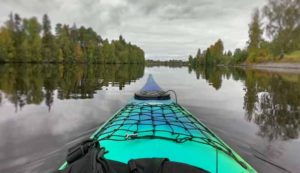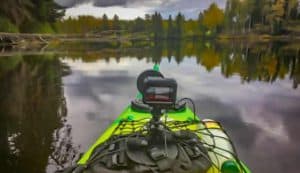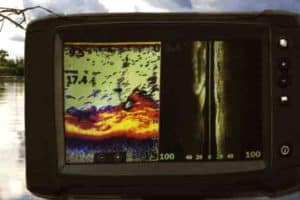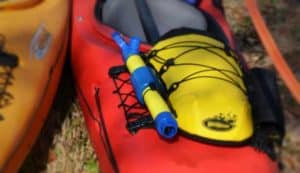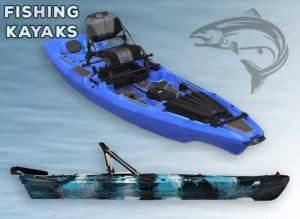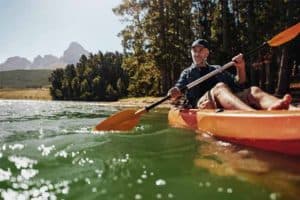This page may have Commerce Content. If you buy something from our posts, we may get a small share of the sale. Click here for more.
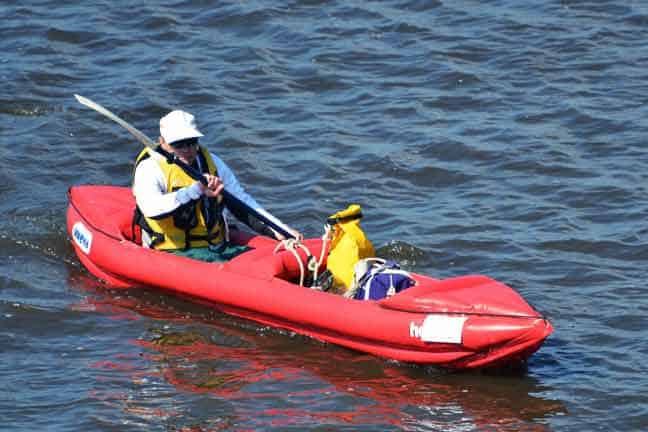

Editor & Article Writer for Outdoor Wilds
As an Amazon Associate I earn from qualifying purchases. Thank you for helping to support the site.
Introduction
It’s one of the greatest senses of freedom paddling down a river in your kayak. Inflatable kayaks add to that freedom in that they can be deployed with ease from the trunk of your vehicle.
This article covers some of the lesser touched upon inflatable kayaking tips for beginners that will help you benefit and enjoy the most from this wonderful sport.
Inflatable Kayaking Tips For Beginners
All the hints and tips are not essential, but are definitely worth considering before you embark on your first kayak outing.
Read my guide If you’re looking for a budget inflatable kayak to get you started in enjoying this great sport.
Kayak Skills Course
The American Canoe Association (ACA) I would suggest is the best place to consider looking into kayaking skills courses.
They have online courses and also provide a resource for finding your nearest kayaking club that will further be able to teach the basics.
Wear A Life Jacket
I would always advise to wear a life jacket or personal floatation device (PFD) when on the water in a kayak.
Each US State will have a Marine Service Bureau that will provide information on whether it is a legal requirement. Most will insist that children under a certain age must wear a life jacket or PFD, usually 13 years of age.
Last update on 2024-04-26 / Affiliate links / Images from Amazon Product Advertising API
Learn To Get Into And Out Of A Kayak
There are a number of basic techniques on how to get in and out of your inflatable kayak. It’s worth spending some time learning these techniques on dry land before embarking on your first paddle.
Once you have a basic understanding of the techniques find a suitable area on the shore of a river and practice.
Kayaking Posts
Use a Pump With a Pressure Gauge
Some kayaks come supplied with a simple foot pump which is nothing more than the pump you would use at the beach. So it’s worth investing little extra on a pump with a built in pressure gauge.
It depends on which model of inflatable kayak you have. The more expensive models will have separate bulkheads, a bulkhead being a separate compartment of air.
These bulkheads must be inflated to the correct air pressure which is critical. Always be aware of the correct air pressure for each.
Adjust the Inflatable Kayak Seating and footrests on Dry Land
Check the configuration of your inflatable kayak beforehand. Some kayaks come with 2 or even a 3 seating arrangement.
The footrest or foot pegs as they are known by, may allow for adjustment to suit your height.
Alternately the kayak may have foot straps that need to be adjusted. In essence make sure your sat as comfortably as possible that the model of inflatable kayak will allow you to.
Muscles used in kayaking: Learn to use your core muscles
There are a number of ways to paddle a kayak and all of them use your shoulder and arm muscles.
However it’s important to use your core muscles too when pulling each stroke. This will ensure you don’t tire too quickly.
The first basic kayaking paddle stroke you will learn is the forward stroke. This paddle stroke will teach you how to use all the muscles in your torso as well as your arms and shoulders, enabling you to produce more power in the stroke and lessen the impact on your arms.
Keep Stuff Dry When Kayaking
Dry bags are the ideal solution to put all your valuables into when kayaking.
These bags will float if you capsize and can be tethered to the kayak.
They’re fairly inexpensive to buy, so well worth having to keep your mobile phone and vehicle keys safe inside a waterproof dry bag that won’t sink to the bottom.
Last update on 2024-03-31 / Affiliate links / Images from Amazon Product Advertising API
Stop Paddle Drip
Depending on the paddle you have, it’s worth having drip rings or splash guards, as some folk call them fitted to both sides of the paddle to stop water from running down the shaft of the paddle and onto your wrists and lap.
Splash guards are just simple rubber rings that are easy to fit to the paddle and cost very little to purchase and will stop kayak paddle drip.

Wear Kayak Paddling Gloves
You will thank me for this one I’m sure. If your paddling for any length of time, the skin between your thumb and index finger will start to chafe and blister.
There’s a tonne of paddling gloves to choose from and wearing a pair of kayak paddling gloves will make sure your time on the water is more enjoyable.
 SUJAYU Fishing Gloves Men & Women, Sailing Gloves...
$8.99
SUJAYU Fishing Gloves Men & Women, Sailing Gloves...
$8.99
Last update on 2024-03-31 / Affiliate links / Images from Amazon Product Advertising API
Kayak Paddle Leash
An inflatable kayak without a paddle is not much more than an inflatable toy some might say. If you do go overboard for any reason then even a slight current will separate the paddle by distance from the kayak and you.
Using a basic paddle leash will ensure that kayak and paddle are always together when you do re-enter the kayak from the water.
 OCEANBROAD Kayak Paddle Leash with D-Ring...
$6.29
OCEANBROAD Kayak Paddle Leash with D-Ring...
$6.29
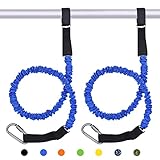 VNVM Kayak Paddle Leash 2 Pack, Paddle Leash...
$9.99
VNVM Kayak Paddle Leash 2 Pack, Paddle Leash...
$9.99
Last update on 2024-03-31 / Affiliate links / Images from Amazon Product Advertising API
Don’t Loose The Skeg
Certain models of inflatable kayak come with a detachable skeg, a skeg being a plastic fin that extends under the hull of the kayak. A kayak without a skeg will not be able to travel in a straight line, especially if there is a cross wind.
I have known owners of some inflatable kayaks lose the skeg due to the fitting not being snug enough, therefore the skeg falls off. To stop this happening to you, drill a small hole into the top of the skeg shaft and attach a simple leash up into the kayak.
Only do this if you think you stand a chance of losing the skeg. It really does depend on the model of inflatable kayak so it’s worth testing before entering the water for the first time.
Paddle near dry land
Until you become really confident with your technique of paddling and stability with in an inflatable kayak. I would always suggest it’s best to paddle fairly close to dry land.
If you do enter the water and can’t climb back into your kayak you can use the kayak as a giant floatation device to leg kick back to shore.
Carry food and water
Depending on how long you aim to be on the water it’s always worth just putting a small bottle of water and a few energy bars into your dry bag before setting off. Kayaking is great exercise and uses a lot of calories to paddle distances.
Summary
Although some of these tips are not essential to follow, they will ensure that your first paddle in an inflatable kayak is a more enjoyable one. Stay safe and happy paddling!
Kayak Posts



